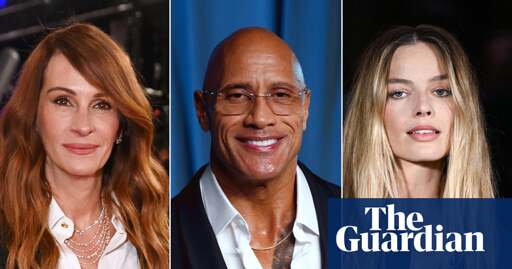Movie stars have been on a journey this fall, and it hasn’t been especially big, bold or beautiful. Actually, on second thought, maybe there is something bold about the way audiences have rejected, in quick succession, new movies collectively starring Margot Robbie, Colin Farrell, Dwayne Johnson, Emily Blunt, Channing Tatum, Kristen Dunst, Jennifer Lopez, Julia Roberts, Andrew Garfield, Keanu Reeves, Seth Rogen and none other than Daniel Day-Lewis. This group of actors that would constitute an especially star-studded Oscars broadcast couldn’t muster a single hit among them. Even Leonardo DiCaprio must accept his status as the exception that proves the rule: his movie One Battle After Another is heading toward a respectable $200m worldwide – and all it took was one of the biggest stars in the world with support from familiar faces Sean Penn and Benicio del Toro, a multiple-time Oscar nominee directing with an Imax-sized budget, and almost universally rapturous reviews. Put all that together in an adult-driven drama and maybe you can outgross, and lose somewhat less money than, Disney’s Snow White remake. (One Battle is unlikely to turn a profit on its theatrical release.)
Meanwhile, movies such as A Big Bold Beautiful Journey, The Smashing Machine, Roofman, After the Hunt, Good Fortune, Kiss of the Spider Woman and Anemone had no such constellation of exciting elements forming in their orbit alongside their stars. Some of them couldn’t even manage particularly great reviews. But that used to be what movie stars were there to provide: some kind of baseline level of interest in a movie, even if it wasn’t getting best-of-year reviews or boasting cutting-edge spectacle. None of the aforementioned stars are expected to perform with the superhuman consistency of Tom Cruise between 1986 and 2006 or Will Smith between 1996 and 2016. But there used to be a certain number of dramas and comedies that would make $50m or more in the US every year as a matter of course, the ones with stars tending to have an advantage in that respect.
My god, are those some long grafs. It’s at least tangentially brought up later in the piece that seeing a movie is really fucking expensive when you’re also paying $7/pound for 80/20 ground beef.



Sort of answered your own question. Who still wants to go to the theater? Cinephiles, people who are happier when they are watching at least one movie a week. I’m friends with a few, and in my experience, these folks prefer a public movie theater, even though they know that home-viewing is a better experience. The cinephiles in my life are broke, they hate people who talk in the movie theater, they get stressed about getting to the movie on time, and they dislike intense bass. All of these are problems that can be easily solved by just watching the movie at home, where even a modest TV can provide superior contrast compared to a theater projection screen. Yet the cinephiles still prefer the theater, because there is something about the vibe that just speaks to them.
I think this is the sort of person that will keep theaters alive into the future, and moviegoing will become a niche hobby for exactly this reason. Indie theaters are already a thing, and I’m inclined to believe that they are the only theaters that will survive this shift. Cinephiles don’t care to see most of these A-lister movies that are coming out now, and mainstream moviegoers are increasingly preferring streaming. The only thing i’m uncertain of is how many younger folks are becoming cinephiles.